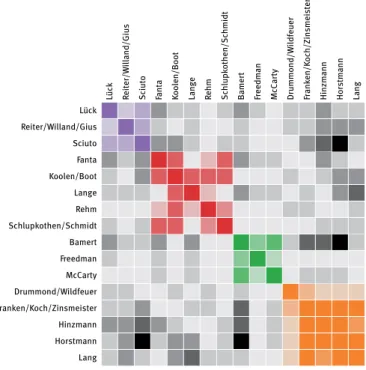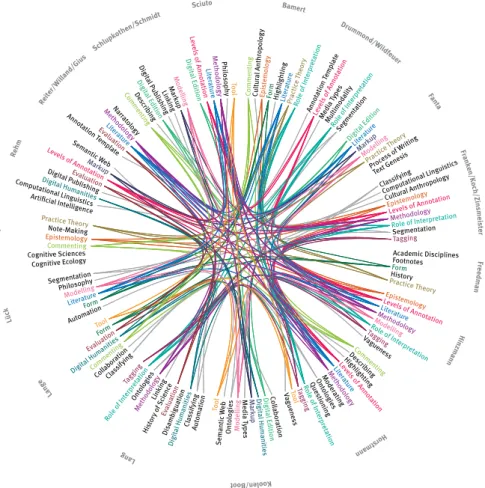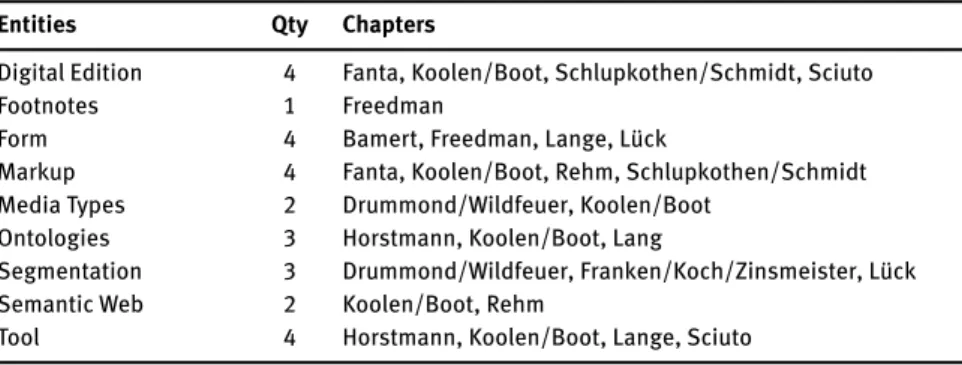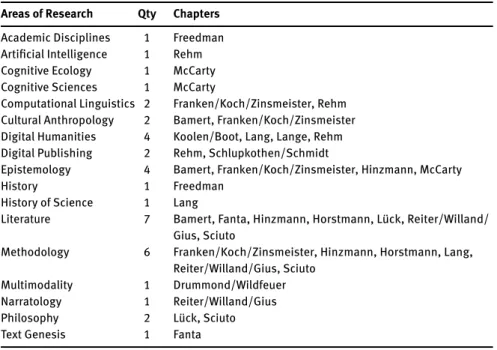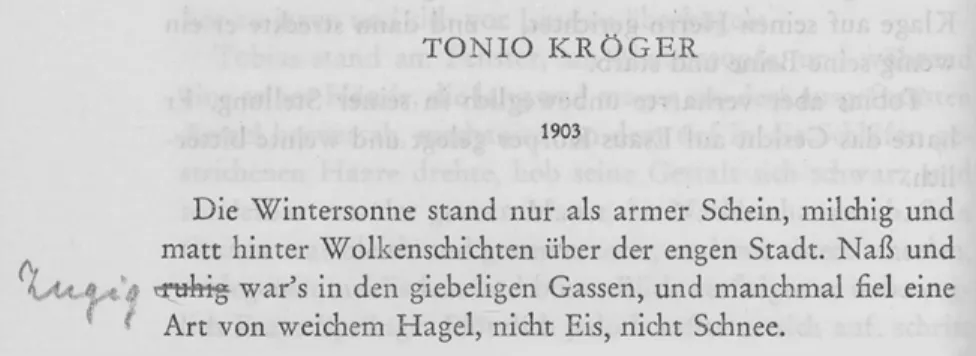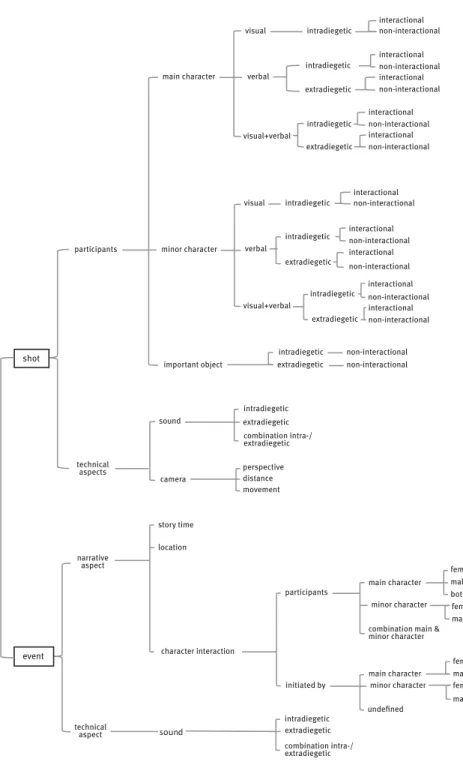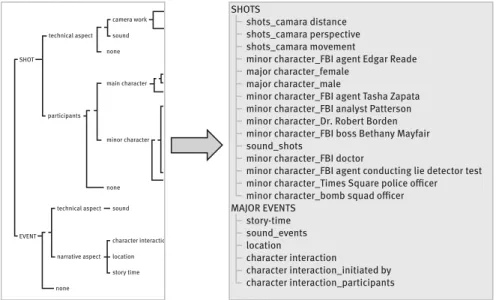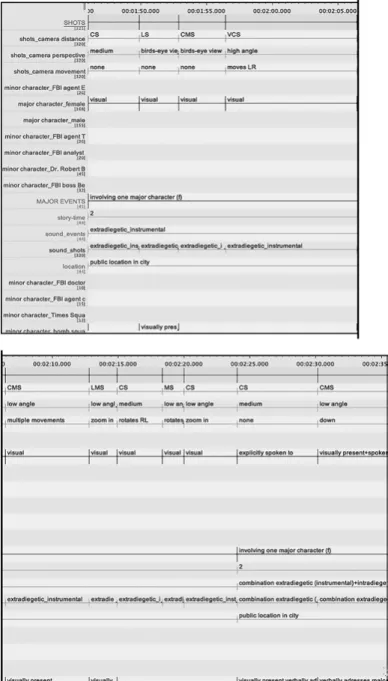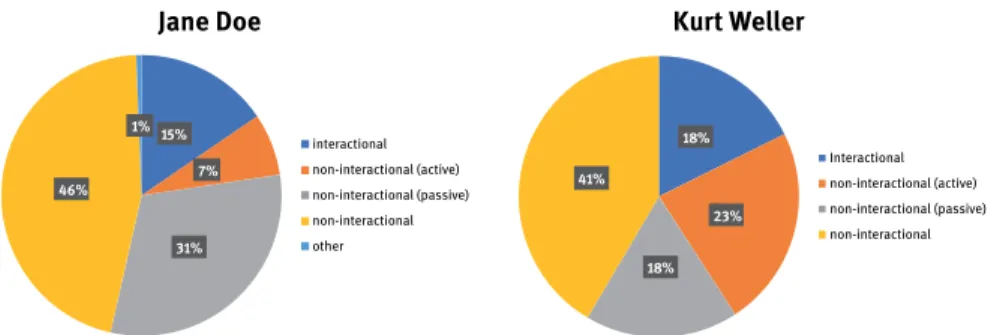Annotations in
Scholarly Editions and Research
Functions, Differentiation, Systematization Edited by
Julia Nantke and Frederik Schlupkothen
ISBN 978-3-11-063601-7 e-ISBN (PDF) 978-3-11-068911-2 e-ISBN (EPUB) 978-3-11-068917-4
DOI https://doi.org/10.1515/9783110689112
This work is licensed under the Creative Commons Attribution-NonCommercial- NoDerivatives 4.0 International License. For details go to http://creativecommons.org/
licenses/by-nc-nd/4.0/.
Library of Congress Control Number: 2020942012
Bibliographic information published by the Deutsche Nationalbibliothek
The Deutsche Nationalbibliothek lists this publication in the Deutsche Nationalbibliografie;
detailed bibliographic data are available on the Internet at http://dnb.dnb.de.
© 2020 Julia Nantke and Frederik Schlupkothen, published by Walter de Gruyter GmbH, Berlin/Boston.
The book is published with open access at www.degruyter.com.
Cover image: Michael Ruml, Bergische Universität Wuppertal
Typesetting: Michael Ruml and Frederik Schlupkothen, University of Wuppertal Printing and binding: CPI books GmbH, Leck.
www.degruyter.com
The editors would like to thank all authors of this volume and all participants of the preceding conference at the University of Wuppertal from 20 to 22 February 2019 for the congenial atmosphere and the very instructive exchange across disciplinary and language boundaries; we hope to have captured this spirit in the volume.
Furthermore, we would like to thank both the DFG-funded Research Training Group 2196 “Document – Text – Editing. Conditions and Forms of Transformation and Modeling: a Transdisciplinary Perspective” and its members for providing a perfect setting for the event, as well as the Fritz Thyssen Foundation for the generous funding of both the conference and the volume at hand. The realization of this undertaking would not have been possible without these institutions.
Hamburg and Wuppertal, February 2020
Julia Nantke Frederik Schlupkothen
Open Access. © 2020 Julia Nantke and Frederik Schlupkothen, published by De Gruyter.
This work is licensed under the Creative Commons Attribution-NonCommercial-NoDerivatives 4.0 License.
https://doi.org/10.1515/9783110689112-202
Julia Nantke and Frederik Schlupkothen Introduction|1
Manuel Bamert
„Aha!“ – Annotieren mit Stiften als epistemische Praxis|19 Tamara Drummond and Janina Wildfeuer
The Multimodal Annotation of Gender Differences in Contemporary TV Series|35
Walter Fanta
Ein Schema für das Schreiben|59
Lina Franken, Gertraud Koch und Heike Zinsmeister Annotationen als Instrument der Strukturierung|89 Joseph S. Freedman
Footnotes (as Annotations) in Historical Context and Their Relevance for Digital Humanities in Our Time|109
Maria Hinzmann
‚Annotationsspiralen‘ und ‚hermeneutischer Zirkel‘?|131 Jan Horstmann
Undogmatic Literary Annotation with CATMA|157 Marijn Koolen and Peter Boot
Facilitating Reusable Third-Party Annotations in Digital Editions|177 Sarah Lang
Digitale Annotation alchemischer Decknamen|201 Felix Lange
An Online Field Study on Scholarly Journal Annotations|221
Christian Lück
Beispiele annotieren|249 Willard McCarty
Making and Studying Notes|271 Georg Rehm
Observations on Annotations|299 Nils Reiter, Marcus Willand und Evelyn Gius
Die Erstellung von Annotationsrichtlinien als Community-Aufgabe für die Digitalen Geisteswissenschaften|325
Frederik Schlupkothen and Karl-Heinrich Schmidt
‘Commentary’ and ‘Explanatory Note’ in Editorial Studies and Digital Publishing|351
Ruggero Sciuto
A ‘Reversible Figure Annotation System’ for the Born-Digital Critical Edition of d’Holbach’s Complete Works|373
List of Contributors|391 Index|399
Introduction
Annotations in Scholarly Editions and Research
The practice of annotating is a cultural technique used since the Middle Ages in various religious, scholarly and everyday contexts. In the twentieth century it has also become a central principle used in information technological systems. Due to its historical impact, the term ‘annotation’ unites different concepts that vary in coverage, application and direction but which also have instructive parallels. In the Humanities, the term traditionally refers to an additional contextualization and explanation of a text added by the author of the text, a different scribe or an editor. Therefore, annotations are equally objects and tools of research, since they build bridges between the perception and the production of knowledge (see Boot 2009, 204). Annotations establish a ‘dialogical structure’ that explicitly links a text passage or an image to its translation, its explanation and/or another artefact, and thereby gives information about the use of the annotated object in a certain time, culture or situation (see Moulin 2010; Meister forthcoming). Hence, anno- tations always represent a specific perspective on the object, one that is shaped not only by the general circumstances of their origin but also by a designated conceptual purpose and a certain scholarly and/or personal point of view: “The core of explanatory annotation can be found in hermeneutics” (Zirker and Bauer 2017, 147). ‘Explanatory’ here can be understood in a twofold way: annotations can be intended to explain something to another reader, or they can be traces of perception processes, i.e. the recipient explains something to her- or himself by annotating. This also means that every annotation, no matter whether it is made for public or private use and whether it includes words and sentences, special characters or takes the form of just underlining and other markings, takes part in modelling the object for its further recipients – whether this is intended by the annotator or not.
From the perspective of Information Technology, the term ‘annotation’ can already refer to the use of processable markup on data sets. Furthermore, the notion can refer to structured keyword indexing or metadata descriptions, e.g. by means of formal languages and standardized technologies of the Semantic Web (see Shadbolt et al. 2006). Thus, annotations in IT contain additional information
Julia Nantke,Institut für Germanistik, Universität Hamburg
Frederik Schlupkothen,School of Electrical, Information and Media Engineering, University of Wuppertal
Open Access. © 2020 Julia Nantke and Frederik Schlupkothen, published by De Gruyter.
This work is licensed under the Creative Commons Attribution-NonCommercial-NoDerivatives 4.0 License.
https://doi.org/10.1515/9783110689112-001
as well, yet are not necessarily intended for a human reader but for an automated processing system. In this context, the explanatory function of annotations aims at making a given text semantically accessible to a computer program in the first place.
As these annotations usually follow a specific world conception, e.g. described by means of controlled vocabularies or ontology languages, their reasoning systems are often caught within a particular ‘reality’.
The Web Annotation Working Group of the World Wide Web Consortium (W3C) has made the attempt to consolidate the classic concept of human-targeted an- notations with a technical model that adds a new layer to the web in order to interlink web resources with human-readable annotations by means of Semantic Web technologies (Ciccarese et al. 2017a, 2017b). These web annotations are based on general linking standards that allow the creation of references to resources of various media types (text, images, videos, etc.) or their respective fragments (e.g.
time- or space-based).
Both the Humanities and Technical Sciences use annotations to provide ma- terial with some sort of organizing framework to guide its further processing. It is precisely this conceptual overlap between the Humanities and the Technical Sciences that unfolds its heuristic potential in the context of the Digital Humanities.
At the same time the multiplication of the conceptual range of annotations and the divergences in knowledge-building practices in the Humanities and in the Technical Sciences harbour a heightened potential for confusion. The practice of annotating is becoming one of the central epistemological techniques, especially in the field of the Digital Humanities (see Kindley 2015), but at the same time the term ‘annotation’ “is not clearly defined, and its methodological foundations have not really been well researched” (Zirker and Bauer 2017, 145; see also Lordick et al.
2016, 188; Walkowski 2016, 6n.). The heuristic potential of annotations and the lack of their scholarly foundation both result from an interrelation of theoretical perspectives and scholarly practices in the interdisciplinary ‘contact zone’ of the Humanities and Technical Sciences. The progressively established use of digital methods in scholarly editions and research in the Humanities is changing anno- tation practices (see Landow 2006, 102–107; McCarty 2002). This is the case on the one hand because the annotation guidelines of the Text Encoding Initiative (TEI; Burnard and Bauman 2015) are now to be regarded as the “de facto stan- dard” (Sahle 2013, 341) for the production of digital and printed scholarly editions and machine-readable digital text corpora in the Humanities. On the other hand, digital publications are integrated via metadata standards such as the Integrated Authority File of the German National Library (GND), the Guidelines for the De- scription of Personal Paper and Manuscript Collections (RNA) or the Functional Requirements for Bibliographical Records (FRBR) into extensive, centrally con-
figured networks by using annotations.¹ The epistemic impact of this procedure can hardly be overestimated (see Nantke 2019). In all these cases, annotations no longer serve merely as supplementary commentaries, but have a significant structuring effect on the appearance, perception and use of texts. Formalized on- tologies decide how texts are sorted, how they can be searched and which parts of them are marked as relevant. Markup languages form an additional level of the
‘actual’ text, but often remain largely invisible to the human recipients. Because of this omnipresence of annotations in digital environments, we need to reflect on their theoretical impact and relation to existing text theories that stem from the sphere of analogue publishing. This holds true especially because of the partial invisibility of their structuring effects.
Besides their use in editorial contexts, there are several projects in the Digital Humanities that – like the TEI Guidelines – aim at the development of overarching concepts, guidelines and tools for semantic annotation to support the analysis and interpretation of corpora used in and for the Humanities.² The heuristic scope of these projects often reaches far beyond mere representation of or commenting on texts. For example, narratological or genre-specific features are translated into machine-readable tagsets or ontologies that are used to explicitly add epistemolog- ical and interpretive perspectives to the texts via annotation (see Gius and Jacke 2015; Meister 2012; Nantke 2017, 93–96). These projects in particular show how annotation practices change as a result of the use of digital tools and environments.
They illustrate that transferring the long-standing practices of the Humanities into digital environments must be accompanied by reflection on the epistemic implications of these practices and their transmission (see McCarty 2020 in this volume).
Annotations in digital environments are potentially entered automatically or collaboratively (see Jannidis 2010, 550; Landow 2006, 103–107). This multiplica- tion of annotation scenarios also manifests itself on a conceptual level: complex annotation schemes for manually annotating selected materials are joined by flat
1 See e.g. http://www.dnb.de/DE/Standardisierung/GND/gnd_node.html; http://kalliope-ver bund.info/_Resources/Persistent/5bf5cd96ea4448bfec20caf2e3d3063344d76b58/rna-berlin-wien- mastercopy-08-02-2010.pdf; https://www.ifla.org/files/assets/cataloguing/frbr/frbr.pdf (27.01.
2020).
2 See the list of “Annotation Tools” compiled by DARIAH-DE at https://docs.google.com/
spreadsheets/d/1pScqOukgq3gLkL51fA_VUw9ubs_I08NwNJde-g3LEis/edit#gid=0 (27.01.2020), the “Bibliography of Tools” in Siemens et al. (2017, 171–173) and the following projects: heureCLÉA – Collaborative Literature Exploration & Annotation: http://heureclea.de (27.01.2020); POSTDATA – Poetry Standardization and Linked Open Data: http://postdata.linhd.es (27.01.2020); Shared Tasks in the Digital Humanities: https://sharedtasksinthedh.github.io (27.01.2020). For the last project see also Reiter et al. (2020) in this volume.
and highly formalized tagsets for fully automated indexing of mass data (see Rehm 2020 in this volume). This, again, influences the theoretical level, since annotations are no longer defined as the research achievements of a few specialized scholars, as used to be the case e.g. in analogue scholarly editions, but can also be the result of algorithmic computing or swarm intelligence (for the latter see Meister 2012).³
Additionally, in contrast to the aforementioned invisibility in digital envi- ronments, annotations can gain a new level of visibility here, too. In the past, annotations for e.g. highlighting, classifying or commenting that were made dur- ing the research process remained invisible to the public in most cases. In digital environments they can be made visible again, e.g. through a set of partially com- bined features such as colours, underlining, clickable links or popup windows.
Public visibility contributes to an increased relevance of these traces of schol- arly practice by approximating them to analogue structures such as marginalia in ancient books or apparatus critici in printed scholarly editions. At the same time, the visualizations benefit from digitization. Because of the possibilities for switching between numerous levels of annotation in the visualizations, digital infrastructures enable arranging annotations for different purposes and/or from different persons much more transparently than what is possible in analogue envi- ronments with more confined storage space (see Horstmann forthcoming). Here, again, the changed practice converges with a changed theoretical mindset, since in literally putting a focus on annotations by the scholarly community or for the purposes of dealing with the texts of others, scholarly reading and writing become visible and describable in their interrelated work stages. This applies to natively digital research processes and also to formerly analogue working drafts that are made visible e.g. in digital scholarly editions. In this context, annotations can help to examine and understand the parallels between analogue and digital research practices. Nevertheless, annotating as part of the heuristic acquisition of a text becomes more ‘strategic’ in digital space, because no matter how “undogmatic”
(see https://catma.de [27.01.2020] and Horstmann 2020 in this volume), it requires more prearrangement and formal precision than sketching with a pen on paper.⁴ The reorientation in the course of digitization in the Humanities and the reflec- tion on its impact on the notion of annotation also draw attention to the already existing diversity of perspectives and objectives associated with the concept of annotation within the Humanities and the Technical Sciences respectively. Thus, even from a ‘classical’ Humanities perspective, the concept of annotation is not
3 However, as Moulin (2010, 21) describes, medieval annotations were carried out in ‘teamwork’
by several different scribes as well.
4 Horstmann (forthcoming) also points out various desiderata of digital visualizations in compar- ison with analogue environments and depicts attempts to solve them.
clearly defined in its scope and boundaries. The forms and functions of explana- tory editorial annotations have been the subject of scholarly debates ever since the 1970s (see e.g. Assmann and Gladigow 1995; Frühwald et al. 1975; Martens 1993a). On the one hand, the discussions on the patronising effect of annotated comments that were part of these debates lose relevance when annotation becomes a collaborative practice. On the other hand, the challenge of making “assignments of meaning from a multitude of possibilities and alternatives”⁵ gains even more importance in digital environments where the processing system relies on unambi- guity and uniqueness. Additionally, the question of whether a common ground of understanding can be established through local annotations (Martens 1993b, 44) meets with the conjuncture that “annotations of parts of the text presuppose its overall complete understanding which they are, in turn, supposed to provide”
(Zirker and Bauer 2017, 147). Both observations point to the general problem of inevitable interpretive choices and semantic losses in the process of making mean- ing explicit through annotation, which is also relevant e.g. for the annotation of manuscript features described by the TEI.
The established document and annotation description languages derive from technical representations that were designed for a very specific purpose: preparing documents in the publishing industry. These efforts led to the Standard General- ized Markup Language (SGML; ISO 8879:1986) and eventually to the Extensible Markup Language (XML; Bray et al. 1998). On these bases the TEI was founded as a consortium to establish a digital format for the exchange of texts from Cul- tural Studies and the Humanities. This endeavour, as with other application areas of XML, brought about the inception of different paradigms (document – data – ontology) that exceed the description of the form of a document, but follow more formal representations of the given content. This “grammatization” of document representations (Pédauque 2006, 90–97) can be traced in the development of XML- based description languages for annotations as well. Accordingly, the example of the Annotated XML Specification provides a reference implementation for the publication of natural language annotations (Bray 1998), whereupon the Annotea project (Kahan et al. 2002) and finally Web Annotations (Ciccarese et al. 2017b) provide more and more formal descriptions not only of the annotations themselves, but also of their embedding and context of use.
These examples illustrate the benefits of envisioning analogue and digital enrichment practices in a historical perspective. Critical reflection on their con- tinuities and differences can help identify requirements for further systematic development in the course of digital practices (see Meister forthcoming) and lead 5Our translation of “Sinnzuweisungen aus einer Fülle von Möglichkeiten und Alternativen”
(Martens 1993b, 38).
to an approximation of what can be seen as the core of the concept of annotation.⁶ Furthermore, comparing different current practices of annotation gives rise to questions concerning the respective range of the annotation concept as well as potential reorientations in the light of recent changes in scholarly practices.
These considerations stood behind an interdisciplinary conference that took place at the University of Wuppertal in February 2019. Our goal was to reflect on var- ious annotation practices and their associated theoretical perspectives and to relate these practices to each other. Participants from seven countries as well as from sev- eral different disciplines in the Humanities and Technical Sciences took part in the conference. The outcomes of their presentations and the very fruitful debates are presented in this volume. The articles range from historical, epistemological and quantitative investigations of annotation practices (Bamert, Freedman, Hinzmann, Lange, McCarty) to presentations of methodologies and tools for systematically annotating digital corpora (Drummond/Wildfeuer, Franken/Koch/Zinsmeister, Horstmann, Reiter/Willand/Gius, Sciuto), from attempts to capture cultural expres- sions of various centuries with machine-readable tagsets (Fanta, Lang, Lück) to considerations about the potential of formalizing annotation structures according to standards of the World Wide Web (Koolen/Boot, Rehm, Schlupkothen/Schmidt).
Depending on the conceptual viewpoint, the scope of what is described as ‘an- notation’ varies in the contributions, ranging from concrete verbal formations such as footnotes (Freedman), explanatory annotations in scholarly editions (Schlupkothen/Schmidt, Sciuto) or XML tags (Koolen/Boot, Fanta) to wider conceptualizations that also include non-verbal forms of expression (Bamert, Drummond/Wildfeuer) or notes that are made on separate material (McCarty).
These differences again show the multifaceted nature of the phenomenon ‘annota- tion’. But at the same time these differences point to ‘layout/materiality’, ‘mode of expression’ and ‘position in relation to the primary object’ as central aspects that can help to structure occurrences of annotation.
Coming from a praxeological perspective, the volume aims at critically re- flecting on the concept of annotation as well as categorizing commonalities and divergences between the different notions of annotation. The conference made very clear, though, that in the case of annotation practices, systematization cannot be achieved by clear distinctions between analogue and digital or by allocating each example of annotation to one specific category. For example, the differentiation
6 Likewise, investigations of paratextual elements such as footnotes and marginalia in various media and material formats are an increasingly recognized field of research in terms of its relevance for the history of scholarship (see e.g. Freedman 2016, 14–20; Grafton 1997; Metz and Zubarik 2008; and the project Glossenedition/Editing glosses [LMUexcellent] https://www.mueze.uni- muenchen.de/editing_glosses/index.html [27.01.2020]).
between ‘annotation as a tool’ and ‘methodological aspects of annotation’, which we had suggested for the conference sections, is instructive as a heuristic means, but in fact those two aspects are very much interwoven in practice, since the con- struction of annotation tools is always shaped by methodological assumptions and requirements and, conversely, the use of a certain tool determines the method(s) of annotating (see Nantke forthcoming). Additionally, the talks and discussions revealed many interconnections between topics that, at first glance, seemed quite far apart. This was the reason why we considered an alternative way of structuring this volume. We assumed that instead of solely providing a linear table of con- tents, the proceedings would better meet the goal of the conference by dynamically connecting the articles by annotating them using keywords. The subject of our conference has thus had a direct impact on the structure of this publication as well.
Hence, the structure of this volume now follows two classification schemes:
one formal and one substantial. The articles firstly appear in the alphabetical order of the authors’ names. Secondly, we aim at systematizing aspects of the concept of annotation and contextualizing the different approaches to annotating by establishing a set of potential keywords. Table 1 on the following page presents an overview of the central aspects of annotation as they are outlined by the articles in this volume.
The assignment of keywords now makes it possible e.g. to differentiate be- tween articles that address annotation as a tool (Koolen/Boot), methodological aspects of annotation (Hinzmann, Lang) or both (Horstmann, Sciuto), and there- fore to provide a more nuanced approach to the interrelations between these two perspectives.
The concept of this outline was developed by the participants during the conference. It led to a collaboratively developed concrete ‘tagset’, according to which we finally arranged the articles in the four sectionsConceptions,Practices, EntitiesandAreas of Researchas shown in Tables 2–5 on pages 13–14.
We arrived at this final result by compiling a list of possible keywords based on the keywords collected during the closing discussion and the conference sec- tion titles (Form,Levels of Annotation,Annotation as a Tool,Methodology,On- tologies). Additionally, we adopted and included further existing taxonomies in our pool of keywords: in particular the W3C’s descriptions of user intent for the creation of annotations, the Taxonomy of Digital Research Activities in the Humanities (TaDiRAH) and the Computing Classification System of the Associ- ation for Computing Machinery (ACM).⁷ We recommended that the participants 7 https://www.w3.org/TR/annotation-vocab/; http://tadirah.dariah.eu/vocab/index.php;
https://dl.acm.org/ccs/ (27.01.2020).
Tab. 1:Chapter classification
Chapter Keywords⁸
Bamert Practice Theory, Role of Interpretation, Commenting, Highlighting, Form, Cultural Anthropology, Epistemology, Literature
Drummond/Wildfeuer Annotation Template, Levels of Annotation, Role of Interpretation, Media Types, Segmentation, Multimodality
Fanta Practice Theory, Process of Writing, Modelling, Digital Edition, Markup, Literature, Text Genesis
Franken/Koch/Zinsmeister Levels of Annotation, Role of Interpretation, Classifying, Tagging, Segmentation, Computational Linguistics, Cultural Anthropology, Epistemology, Methodology
Freedman Practice Theory, Footnotes, Form, Academic Disciplines, History Hinzmann Levels of Annotation, Role of Interpretation, Vagueness, Modelling,
Tagging, Epistemology, Literature, Methodology Horstmann Levels of Annotation, Role of Interpretation, Vagueness,
Commenting, Describing, Highlighting, Moderating, Questioning, Tagging, Ontologies, Tool, Literature, Methodology
Koolen/Boot Collaboration, Modelling, Digital Edition, Markup, Media Types, Ontologies, Semantic Web, Tool, Digital Humanities
Lang Automation, Disambiguation, Evaluation, Role of Interpretation, Classifying, Linking, Tagging, Ontologies, Digital Humanities, History of Science, Methodology
Lange Collaboration, Evaluation, Classifying, Commenting, Form, Tool, Digital Humanities
Lück Automation, Modelling, Form, Segmentation, Literature, Philosophy
McCarty Practice Theory, Commenting, Note-Making, Cognitive Ecology, Cognitive Sciences, Epistemology
Rehm Evaluation, Levels of Annotation, Markup, Semantic Web, Artificial Intelligence, Computational Linguistics, Digital Humanities, Digital Publishing
Reiter/Willand/Gius Annotation Template, Evaluation, Literature, Methodology, Narratology
Schlupkothen/Schmidt Commenting, Describing, Linking, Modelling, Digital Edition, Markup, Digital Publishing
Sciuto Levels of Annotation, Digital Edition, Tool, Literature, Methodology, Philosophy
8 The keywords are listed in the order in which they appear in Tables 2–5 on pages 13–14; this order is also used within the respective chapters.
Fig. 1:Word cloud visualization of the overall frequencies of the assigned keywords
refer to these taxonomies, because they all – narrowly or broadly – aim at struc- turing and formalizing aspects that are also related to the concept and practice of annotation and at the same time represent different disciplinary perspectives. In integrating these existing taxonomies into our ‘tagset’ on annotation, we intended to make use of the validation processes by means of which they were constructed, and to place our attempt at systematization within a broader picture of research and modelling activities.
Based on these suggestions, in the first round all participants assigned their contributions to as many keywords as they found relevant. The result already showed a lot of overlaps, but also interesting unique features. In the following editorial process we eliminated synonyms as well as false friends, and developed the final classification in constant exchange with all the authors.
Figure 1 shows that this final set of keywords has significant peaks at the key- wordsRole of InterpretationandLevels of Annotation. These conceptual aspects link a number of articles on very different facets of annotation and belong to the overall most frequently assigned keywords of the volume, as the word cloud shows.
They both point to the complexity of the annotation practices described in this vol- ume: different levels of annotation are needed to adequately capture the structures of cultural artefacts by means of annotation. As discussed above, the digitization of practices in the Humanities entails an increased need for formalization. Therefore, working in digital environments in particular fosters a systematic differentiation of annotation levels, since reflection on the concrete goals of the annotation process is a necessary part of e.g. choosing a specific tool or the basis for designing one.
Bamert
Drummond/Wildfeuer Fanta
Franken/Koch/Zinsmeister Freedman
Hinzmann Horstmann Koolen/Boot
Lang Lange Lück
McCarty Rehm Reiter/Willand/Gius
Schlupkothen/Schmidt Sciuto
Bamert Drummond/Wildfeuer
Fanta Franken/Koch/Zinsmeister
Freedman Hinzmann Horstmann
Koolen/Boot LangLange
Lück McCarty
Rehm
Reiter/Willand/Gius Schlupkothen/Schmidt
Sciuto
Fig. 2:Adjacency matrix and visualization of article groups on the basis of keyword co-occurences
Another outcome of this heightened need for formal precision – it can be presumed by the frequent use of this keyword – is the foregrounding of the important role that interpretation plays in processes of transforming Humanities research questions and practices into more stable, machine-readable formats.⁹
The correlation of a certain perspective on the process of annotation with working in a digital environment is also indicated by the matrix shown in Figure 2.
This adjacency matrix serves to visualize keyword co-occurrences and groups them according to the Louvain method for community detection (see Blondel et al.
2008). Each coloured cell represents the weighted keyword co-occurrences for two articles that appear in the volume, while darker cells indicate articles that share a relatively high number of keywords and the four colour groups (purple, red, green, orange) highlight the detected communities. The large orange cluster encompasses articles that all explicitly deal with theoretical and methodological implications of annotating in digital environments, while e.g. the articles that are grouped in
9 At the same time considerations concerning the role of interpretation, as already mentioned above, have quite a tradition in debates on annotations in the Humanities.
the red cluster are more concerned with the concrete procedures of systematically modelling different media structures by using markup.
A significant focus of the articles in the volume lies onPracticesconnected with the concept of annotation. The set ofPracticesrepresents the most specific category in our systematization and, as the word cloud shows, the keywordsCommenting, ModellingandTaggingare some of the most frequently assigned terms.
Although annotating itself is a scholarly practice and as such is part of a set of
“scholarly primitives” (Unsworth 2000), there are at the same time several other practices related to the concept of annotation. The accumulation of thePractices subset places the concept of annotation in a network of interrelated practices;
this may help to reassert and substantiate its status as a scholarly primitive. E.g.
commenting and tagging are research practices that are directly associated with the concept of annotation. Additionally, the edge bundling visualization of the relations between the articles in Figure 3 on the next page shows e.g. that the keywordCommentingrelates articles on epistemological questions and historical perspectives to more technically oriented contributions.Modelling, however, is a practice that is more explicitly associated with digital approaches, especially in the context of markup.
In addition to theConceptionsandPracticesof annotation, theEntitiessubset expresses the relation between annotations and the objects they are directed at or the formats they are displayed in. This category gives an overview of the wide range of topics related to the concept of annotation that are addressed in this volume. It encompasses broad categories such asToolthat connect several articles on different topics. At the same time e.g. the entityDigital Editionqualifies contributions that deal with the same display format of annotations, andSemantic WeborFootnotes refer to specific formats in the context of annotation that are only addressed in certain articles.
The categoryAreas of Researchis intentionally rather broad and ‘soft’, since it was our goal to facilitate reader orientation in our interdisciplinary publication in the first place. Therefore, we left it to the participants how best to position their contributions. As a result, the category encompasses disciplines such asLinguistics orPhilosophyas well as more specific attributions likeMultimodalityorCognitive Ecology. Nevertheless, the category gives an impression of the main perspectives of the volume. The keywords show a significant accumulation of articles from the fields ofLiteratureandDigital Humanities, as well as onMethodologyand Epistemology. Additionally, as our previous remarks indicate, the tables and vi- sualizations provide a more distinct impression of the substantive scope of the articles. While the adjacency matrix gives a broader impression of certain groups of related articles, the edge bundling visualization can assist in e.g. discovering relations between articles by means of the assigned keywords in detail.
Bamert
Drumm ond/W
ildfeuer Fanta
Franken /Koch
/Zinsm anmeisedterFre
zmHin ann
Horst mann len Koo
/Bo ot g Lan
ngLa e LückMcCarty
Rehm
Reiter/Willand/Gius
Schlupkothen/Schmidt Sciuto
CommentingCultural Anthr
opo logy
Epistemo logy
FormHigh lighting
Literature Practic
e Theor y
Role of Interpr
etation
Annot ation
Temp late
Levels of Annot ation
Medi a Types Multimod ality Role of
Interpretation Segment
ation
Digital Edition Literatur
e Mark
up Model
ling Practic
e Theor y
Process of Writing Text Genesis
Classifying Computational Linguistics
Cultural Anthropology Epistemology
Levels of Annotation Methodology Role of Interpretation Segmentation Tagging Academic Disciplines Footnotes HistoryForm Practice Theory Epistemology Levels of Annot
ation Literature Methodo Model logy Role ofling
Interpr etation Tagging Vaguene Commentingss Describi
ng High
lighting Levels of
Annot ation Literatur
e Methodo
logy Moder
ating Ont
ologie s Que
stioning Role of
Interpr etation Tagging Tool Vaguene
ss Collabor
ation Digit
al Edition Digit al Hu manitie
sM
arkup Media TypesModelling
Ont ologie
s
Sem antic Web Tool Automation Classi
fying
Digit al Humanitie
s
Disam biguation Evaluation Histor
y of Scienc e Linking Methodo
logy Ontologie
s
Role of IntTagerprgingetation Classi
fying Collabor
ation Commenting Digital Humanitie
s EvaTooluationForml AutomFormation Literature Modelling Philosophy Segmentation Cognitive Ecology Cognitive SciencesPractice TheoryEpistemologyCommentingNote-Making Artificial Intelligence Computation
al Lingui stics Digital Humanitie s Digit
al PublishingEvaluation Levels of Annot
ation Markup Semantic
Web Annot
ation Template
EvaluationLiteratur e Methodo
logy Narr
atolog y CommentingDes
cribi ng Digit
al Edition Digit
al Pub lishingLin
king Mark
up Model ling
Digit al Edition Level
s of Annot ationLitera
ture Methodo
log
y
Phi
losop
hy Tool
Fig. 3:Edge bundling visualization of relations between the articles as indicated by the keywords
These considerations make it clear that the keywords and their further categoriza- tion are to be understood as a first attempt to systematize notions of the concept of annotation in an interdisciplinary perspective on the basis of concrete research projects. We do not make a claim to completeness here, but we do hope to have made a valuable contribution to differentiating formats and functions, and system- atizing the interdisciplinary field of annotation practices, by combining first-hand research reports with theoretical reflection from various disciplines in a flexible indexing structure that can be used as a basis for further research on the concept of annotation.
Tab. 2:Chapter classification according to the ‘Conceptions’ tagset
Conceptions Qty Chapters
Annotation Template 2 Drummond/Wildfeuer, Reiter/Willand/Gius
Automation 2 Lang, Lück
Collaboration 2 Koolen/Boot, Lange
Disambiguation 1 Lang
Evaluation 4 Lang, Lange, Rehm, Reiter/Willand/Gius
Levels of Annotation 6 Drummond/Wildfeuer, Franken/Koch/Zinsmeister, Hinzmann, Horstmann, Rehm, Sciuto
Practice Theory 4 Bamert, Fanta, Freedman, McCarty Process of Writing 1 Fanta
Role of Interpretation 6 Bamert, Drummond/Wildfeuer, Franken/Koch/Zinsmeister, Hinzmann, Horstmann, Lang
Vagueness 2 Hinzmann, Horstmann
Tab. 3:Chapter classification according to the ‘Practices’ tagset
Practices Qty Chapters
Classifying 3 Franken/Koch/Zinsmeister, Lang, Lange
Commenting 5 Bamert, Horstmann, Lange, McCarty, Schlupkothen/Schmidt Describing 2 Horstmann, Schlupkothen/Schmidt
Highlighting 2 Bamert, Horstmann
Linking 2 Lang, Schlupkothen/Schmidt
Modelling 5 Fanta, Hinzmann, Koolen/Boot, Lück, Schlupkothen/Schmidt
Moderating 1 Horstmann
Note-Making 1 McCarty
Questioning 1 Horstmann
Tagging 4 Franken/Koch/Zinsmeister, Hinzmann, Horstmann, Lang
Tab. 4:Chapter classification according to the ‘Entities’ tagset
Entities Qty Chapters
Digital Edition 4 Fanta, Koolen/Boot, Schlupkothen/Schmidt, Sciuto
Footnotes 1 Freedman
Form 4 Bamert, Freedman, Lange, Lück
Markup 4 Fanta, Koolen/Boot, Rehm, Schlupkothen/Schmidt Media Types 2 Drummond/Wildfeuer, Koolen/Boot
Ontologies 3 Horstmann, Koolen/Boot, Lang
Segmentation 3 Drummond/Wildfeuer, Franken/Koch/Zinsmeister, Lück
Semantic Web 2 Koolen/Boot, Rehm
Tool 4 Horstmann, Koolen/Boot, Lange, Sciuto
Tab. 5:Chapter classification according to the ‘Areas of Research’ tagset Areas of Research Qty Chapters
Academic Disciplines 1 Freedman Artificial Intelligence 1 Rehm Cognitive Ecology 1 McCarty Cognitive Sciences 1 McCarty
Computational Linguistics 2 Franken/Koch/Zinsmeister, Rehm Cultural Anthropology 2 Bamert, Franken/Koch/Zinsmeister Digital Humanities 4 Koolen/Boot, Lang, Lange, Rehm Digital Publishing 2 Rehm, Schlupkothen/Schmidt
Epistemology 4 Bamert, Franken/Koch/Zinsmeister, Hinzmann, McCarty
History 1 Freedman
History of Science 1 Lang
Literature 7 Bamert, Fanta, Hinzmann, Horstmann, Lück, Reiter/Willand/
Gius, Sciuto
Methodology 6 Franken/Koch/Zinsmeister, Hinzmann, Horstmann, Lang, Reiter/Willand/Gius, Sciuto
Multimodality 1 Drummond/Wildfeuer
Narratology 1 Reiter/Willand/Gius
Philosophy 2 Lück, Sciuto
Text Genesis 1 Fanta
Bibliography
Assmann, Jan and Burkhard Gladigow (Eds.). Text und Kommentar. Archäologie der literarischen Kommunikation IV. Munich: Fink. 1995.
Blondel, Vincent D., Jean-Loup Guillaume, Renaud Lambiotte, and Etienne Lefebvre. Fast Unfolding of Communities in Large Networks. In: Journal of Statistical Mechanics: The- ory and Experiment, 10, P10008. Bristol: IOP Publishing. 2008. DOI: 10.1088/1742- 5468/2008/10/P10008.
Boot, Peter. Mesotext. Digitised Emblems, Modelled Annotations and Humanities Scholarship.
Amsterdam: Pallas proefschriften. 2009.
Bray, Tim, Jean Paoli, and C. M. Sperberg-McQueen. Extensible Markup Language (XML) 1.0. W3C Recommendation. February 1998. URL: https://www.w3.org/TR/1998/REC-xml-19980210 (27.01.2020).
Bray, Tim. Building the Annotated XML Specification. September 1998. URL: https://www.xml.
com/pub/a/98/09/exexegesis-0.html (27.01.2020).
Burnard, Lou and Syd Bauman (Eds.). TEI P5 – Guidelines for Electronic Text Encoding and Interchange. 2.8.0. 6-apr-2015. Technical Report, TEI Consortium, April 2015. URL: http://
www.tei-c.org/Guidelines/P5/ (27.01.2020).
Ciccarese, Paolo, Robert Sanderson, and Benjamin Young. Web Annotation Data Model. W3C Recommendation. February 2017a. URL: https://www.w3.org/TR/2017/REC-annotation- model-20170223/ (27.01.2020).
Ciccarese, Paolo, Robert Sanderson, and Benjamin Young. Web Annotation Vocabulary. W3C Recommendation. February 2017b. URL: https://www.w3.org/TR/2017/REC-annotation- vocab-20170223/ (27.01.2020).
Freedman, Joseph F. Introduction. The Period Around 1670 – Some Questions to Consider.
In: Joseph S. Freedman (Ed.), Die Zeit um 1670. Eine Wende in der europäischen Geschichte und Kultur? Wiesbaden: Harrassowitz Verlag. 2016, pp. 7–73.
Frühwald, Wolfgang, Herbert Kraft, and Walter Müller-Seidel (Eds.). Probleme der Kommen- tierung: Kolloquien der Deutschen Forschungsgemeinschaft Frankfurt am Main 12. bis 14.
Oktober 1970 und 16. bis 18. März 1972. Bonn: Boldt. 1975.
Gius, Evelyn and Janina Jacke. Informatik und Hermeneutik. Zum Mehrwert interdisziplinärer Textanalyse. In: Constanze Baum and Thomas Stäcker (Eds.), Sonderband 1 der ZfdG:
Grenzen und Möglichkeiten der Digital Humanities. 2015. DOI: 10.17175/sb01.
Grafton, Anthony. The Footnote. A Curious History. Cambridge, MA: Harvard University Press.
1997.
Horstmann, Jan. Undogmatic Literary Annotation with CATMA. In: Julia Nantke and Frederik Schlupkothen (Eds.), Annotations in Scholarly Editions and Research. Functions, Differentia- tion, Systematization. Berlin, Boston: De Gruyter. 2020, pp. 157–175.
Horstmann, Jan. Textvisualisierung: Epistemik des Bildlichen im Digitalen. In: Martin Huber, Sybille Krämer, and Claus Pias (Eds.), Wovon sprechen wir, wenn wir von Digitalisierung sprechen? Gehalte und Revisionen zentraler Begriffe des Digitalen. Beiträge zum Sympo- sium “Digitalität in den Geisteswissenschaften” an der Universität Bayreuth, Februar 2019.
Frankfurt a. M.: Universitätsbibliothek Johann Christian Senckenberg. Forthcoming.
ISO 8879:1986. Information processing — Text and office systems — Standard Generalized Markup Language (SGML). Geneva: International Organization for Standardization. 1986.
Jannidis, Fotis. Digital Editions in the Net. Perspectives for Scholarly Editing in a Digital World.
In: Jörgen Schäfer and Peter Gendolla (Eds.), Beyond the Screen. Transformations of Literary Structures, Interfaces and Genres. Bielefeld: Transcript. 2010, pp. 543–560.
Kahan, José, Marja-Riitta Koivunen, Eric Prud’Hommeaux, and Ralph R. Swick. Annotea: An Open RDF Infrastructure for Shared Web Annotations. In: Computer Networks, 39, 5. Amsterdam:
Elsevier. 2002, pp. 589–608.
Kindley, Evan. Down the Rabbit Hole: The Rise, and Rise of Literary Annotation. In: The New Republic. 21.09.2015. URL: http://www.newrepublic.com/article/122678/down-rabbit-hole (27.01.2020).
Landow, George P. Hypertext 3.0. Critical Theory and New Media in an Era of Globalization.
Baltimore: Johns Hopkins University Press. 2006.
Lordick, Harald, Rainer Becker, Michael Bender, Luise Borek, Canan Hastik, Thomas Kollatz, Beata Mache, Andrea Rapp, Ruth Reiche, and Niels-Oliver Walkowski. Digitale Annotationen in der geisteswissenschaftlichen Praxis. In: BIBLIOTHEK – Forschung und Praxis 40, 2.
Berlin: De Gruyter. 2016, pp. 186–199.
Martens, Gunter (Ed.). Kommentierungsverfahren und Kommentarformen: Hamburger Kolloquium der Arbeitsgemeinschaft für Germanistische Edition 4. bis 7. März 1992. Tübingen: Niemeyer.
1993a.
Martens, Gunter. Kommentar – Hilfestellung oder Bevormundung des Lesers? In: Winfried Woesler (Ed.), Editio 7. Tübingen: Niemeyer. 1993b, pp. 36–50.
McCarty, Willard. A Network with a Thousand Entrances: Commentary in an Electronic Age?
In: Roy K. Gibson and Christina Shuttleworth Kraus (Eds.), The Classical Commentary:
History, Practices, Theory. Leiden: Brill. 2002, pp. 359–402.
McCarty, Willard. Making and Studying Notes. Towards a Cognitive Ecology of Annotation. In: Julia Nantke and Frederik Schlupkothen (Eds.), Annotations in Scholarly Editions and Research.
Functions, Differentiation, Systematization. Berlin, Boston: De Gruyter. 2020, pp. 271–297.
Meister, Jan Christoph. Crowd Sourcing ‘True Meaning’: A Collaborative Markup Approach to Textual Interpretation. In: Marilyn Deegan and Willard McCarty (Eds.), Collaborative Research in the Digital Humanities. A Volume in Honour of Harold Short, on the Occasion of his 65th Birthday and his Retirement. Farnham: Ashgate. 2012, pp. 106–122.
Meister, Jan Christoph. Annotation als Markup avant la lettre. In: Fotis Jannidis, Simone Winko, Andrea Rapp, Jan Christoph Meister and Thomas Stäcker (Eds.), Digitale Literaturwis- senschaft. DFG-Symposium Villa Vigoni, 2017. Berlin, Boston: De Gruyter. Forthcoming.
Metz, Bernhard and Sabine Zubarik (Eds.). Am Rande bemerkt. Anmerkungspraktiken in literari- schen Texten. Berlin: Kulturverlag Kadmos. 2008.
Moulin, Claudine. Am Rande der Blätter. Gebrauchsspuren, Glossen und Annotationen in Handschriften und Büchern aus kulturhistorischer Perspektive. In: Quarto 30/31, special issue “Autorenbibliotheken”. Geneva: Editions Slatkine. 2010, pp. 19–26.
Nantke, Julia. Annäherungen an eine digitale Semiotik: Zwischen computergestützter Semiotik und Semiotik als Metadisziplin. In: Zeitschrift für Semiotik 39, 1/2. Tübingen: Stauffenburg Verlag. 2017, pp. 83–108.
Nantke, Julia. Konzepte digitaler Repräsentation von Literatur zwischen Pluralisierung und Standardisierung. In: Martin Huber, Sybille Krämer, and Claus Pias (Eds.), Forschungs- infrastrukturen in den digitalen Geisteswissenschaften. Wie verändern digitale Infra- strukturen die Praxis der Geisteswissenschaften? Frankfurt a. M. 2019, pp. 58–76. URN:
urn:nbn:de:hebis:30:3-526104.
Nantke, Julia. Annotationen. Werkzeug, Methode und Gegenstand in den Digitalen Geisteswis- senschaften. In: Martin Huber, Sybille Krämer, and Claus Pias (Eds.), Wovon sprechen wir, wenn wir von Digitalisierung sprechen? Gehalte und Revisionen zentraler Begriffe des Digitalen. Beiträge zum Symposium “Digitalität in den Geisteswissenschaften” an der Universität Bayreuth, Februar 2019. Frankfurt a. M: Universitätsbibliothek Johann Christian Senckenberg. Forthcoming.
Pédauque, Roger T. Le document à la lumière du numérique. Caen: C&F éditions. 2006.
Rehm, Georg. Observations on Annotations. In: Julia Nantke and Frederik Schlupkothen (Eds.), Annotations in Scholarly Editions and Research. Functions, Differentiation, Systematization.
Berlin, Boston: De Gruyter. 2020, pp. 299–323.
Reiter, Nils, Marcus Willand, and Evelyn Gius. Die Erstellung von Annotationsrichtlinien als Community-Aufgabe für die Digitalen Geisteswissenschaften. Ein Vorschlag zu Shared Tasks in den Digital Humanities. In: Julia Nantke and Frederik Schlupkothen (Eds.), Annotations in Scholarly Editions and Research. Functions, Differentiation, Systematization. Berlin, Boston:
De Gruyter. 2020, pp. 325–350.
Sahle, Patrick. Digitale Editionsformen. Zum Umgang mit der Überlieferung unter den Bedingun- gen des Medienwandels. Teil 3: Textbegriffe und Recodierung. Norderstedt: BoD. 2013.
Shadbolt, Nigel, Tim Berners-Lee, and Wendy Hall. The Semantic Web Revisited. In: IEEE Intelli- gent Systems, 21, 3. Los Alamitos, CA: IEEE Computer Society. 2006, pp. 96–101.
Siemens, Ray, Alyssa Arbuckle, Lindsey Seatter, Randa El Hatib, and Tracey El Hajj. The Value of Plurality in the “Network with a Thousand Entrances”. In: Angelika Zirker and Matthias Bauer (Eds.), International Journal of Humanities and Arts Computing 11, 2, Sonderband:
Explanatory Annotation in the Context of the Digital Humanities. Edinburgh: Edinburgh University Press. 2017, pp. 153–173.
Unsworth, John. Scholarly Primitives: What Methods Do Humanities Researchers Have in Common, and How Might Our Tools Reflect This? In: Symposium on Humanities Computing:
Formal Methods, Experimental Practice. London: King’s College. 2000. URL: http://www.
people.virginia.edu/~jmu2m/Kings.5-00/primitives.html (27.01.2020).
Walkowski, Niels Oliver. Digitale Annotationen: ‚Best Practices‘ und Potentiale (DARIAH-DE Report 6.2.1), Teil I. 29.02.2016. URL: https://wiki.de.dariah.eu/display/publicde/Reports+
and+Milestones (27.01.2020).
Zirker, Angelika and Matthias Bauer. Explanatory Annotation in the Context of the Digital Humanities: Introduction. In: Angelika Zirker and Matthias Bauer (Eds.), International Journal of Humanities and Arts Computing 11, 2, Special issue: Explanatory Annotation in the Context of the Digital Humanities. Edinburgh: Edinburgh University Press. 2017, pp. 145–152.
„Aha!“ – Annotieren mit Stiften als epistemische Praxis
Abstract:Reading notes in books and other printed matter are of increasing interest in Philology and Cultural History. However, we still lack an understanding of their epistemic foundations. With reference to Thomas Mann’s private library, I suggest viewing the act of annotating with pens itself as an epistemic practice.
For this, I introduce the term ‘pen traces’ for all phenomena left behind by pens, and distinguish between four different forms of knowledge that influence their emergence: the knowledge of readers, the knowledge of authors, textual knowledge and contextual knowledge. By shedding light on pen traces as traces of an epistemic practice, finally, I point out the need for a practice theory of annotation.
Keywords:Practice Theory, Role of Interpretation, Commenting, Highlighting, Form, Cultural Anthropology, Epistemology, Literature
1 Einleitung
Als Thomas Mann 1938 an seinem RomanLotte in Weimararbeitete, war sein Schreibprozess, wie für ihn üblich, von umfangreichen Lektüren begleitet. So las er zu dieser Zeit beispielsweise das im gleichen Jahr neu erschienene Buch des Orientalisten Hans Heinrich Schaeder mit dem TitelGoethes Erlebnis des Ostens.
Das Buch, das in der Nachlassbibliothek im Thomas-Mann-Archiv der ETH Zürich erhalten ist, hat Mann indes nicht nur gelesen – er hat es, wie er es an anderer Stelle nennt, „mit dem Bleistift“ gelesen.¹ Will heißen: Er hat darin zahlreiche An- und Unterstreichungen, Ausrufezeichen und Marginalien hinterlassen. An einer Stelle etwa setzt Mann ein „Aha!“ (siehe Abbildung 1 auf Seite 22) an den Rand des Textes und legt damit nahe, dass er hier eine Erkenntnis gewonnen hat.² 1 Wiederholt dokumentiert Mann in seinen Tagebüchern Lektüren auf diese Weise, so zum Beispiel am 18. Mai 1919, am 31. Mai 1921 (siehe Mann 1979, 240, 524) und am 24. Februar 1946 (siehe Mann 1986, 310).
2 Die entsprechende Marginalie findet sich in Schaeder (1938, 30). Alle Abbildungen in die- sem Beitrag entstammen der digitalen Datenbank zu Manns Nachlassbibliothek, der Abdruck erfolgt mit freundlicher Genehmigung des Thomas-Mann-Archivs der ETH Zürich. Siehe zu Abbil- dung 1 Datenbank Thomas Mann Nachlassbibliothek, Thomas Mann 552, Bild 47 (abgerufen am 14.10.2019).
Manuel Bamert,ETH Zürich
Open Access. © 2020 Manuel Bamert, published by De Gruyter. This work is licensed under the Creative Commons Attribution-NonCommercial-NoDerivatives 4.0 License.
https://doi.org/10.1515/9783110689112-002
Rund um diese Phänomene, also um all die mit Stiften in Büchern und anderen Schriften hinterlassenen Lesespuren, hat sich inzwischen eine eigene Disziplin in einem „kulturhistorisch-philologischen Spannungsfeld“ gebildet (Moulin 2010, 20). Die Lesespurenforschung, die ihre wissenschaftshistorischen Wurzeln in der Untersuchung mittelalterlicher Glossen hat (Moulin 2010, 20), dringt in jüngster Zeit vermehrt auch in den digitalen Raum vor, wie etwa die Erschließungs- und Digitalisierungsprojekte zu Thomas Manns (Thomas-Mann-Archiv der ETH Zürich 2019), Herman Melvilles (Olsen-Smith et al. 2008), Theodor Fontanes (Theodor- Fontane-Archiv Potsdam und UCLAB an der Fachhochschule Potsdam 2019) oder Jacques Derridas (Center for Digital Humanities at Princeton 2018) Lesespuren zeigen.
Theoretisch unterbeleuchtet sind auf diesem Feld derweil noch die epistemi- schen Grundlagen solcher Lesespuren. Welcher Wissensgehalt kommt mit Stiften vorgenommenen Annotationen wie dem randständigen „Aha!“ zu? Dieser Fra- ge möchte ich im Folgenden anhand von einigen Beispielen aus Thomas Manns Nachlassbibliothek nachgehen. Dazu werde ich zunächst den Begriff der Anno- tation im Kontext der Lesespurenforschung situieren. Danach nehme ich eine epistemologische Perspektive ein und zeige in Ansätzen auf, wie man die vorge- brachten Phänomene als Spuren epistemischer Praktiken konzeptualisieren kann.
Zuletzt werde ich unter dem Stichwort Praxeologie darauf eingehen, dass eine praxistheoretische Analyse des Annotierens ein größeres Forschungsdesiderat ist.
2 Terminologie
Anders als in der Glossenforschung, die sich um eine einigermaßen etablierte Terminologie bemüht hat (vgl. dazu zum Beispiel Bergmann und Stricker 2009), ist die Lage in der Erschließung und Erforschung von neuzeitlichen Lesespuren typo- logisch und terminologisch ungeklärt. In der Einleitung zum in der deutschspra- chigen Lesespurenforschung bislang umfangreichsten Sammelband mit dem Titel Lesespuren – Spurenlesenverwendet Marcel Atze etwa alleine für durch Schreib- werkzeuge entstandene Lesespuren über 20 verschiedene Begriffe. In der Rei- henfolge ihres Erscheinens im Text sind das: „Bearbeitungsspuren“, „Kommenta- re“, „Korrekturen“, „Nachträge[]“, „Zusätze[]“, „Ergänzungen“, „Eintragungen“,
„Anmerkungen“, „Lesespuren“, „Marginalien“, „Phänomen der Handschrift im Buch“, „Annotationen“, „Randnotizen“, „Einträge“, „Anstreichungen“, „Randglos- sen“, „Randschriften“, „graphische Merkzeichen“, „Randmarkierungen“, „Notizen von des Dichters Hand“, „Randbemerkungen“, „Änderungen“, „Aufzeichnungen“
und schließlich „Lektürespuren“. Diese substantivischen Begriffe werden bei Atze
zudem oft kombiniert mit Verben wie „annotier[en]“ und Adjektiven wie „eigenhän- dig“ oder „handschriftlich“.³ Das Begriffsfeld für die Beschäftigung mit Lesespuren ist also bereits breit abgesteckt. Was hingegen fehlt, sind klare Definitionen, die die untersuchten Phänomene systematisch charakterisieren und voneinander abgrenzen.
Der Begriff der Annotation ist auf diesem Feld nur einer von vielen und sein Geltungsbereich ist unklar. Klar ist einzig, dass er nicht als Synonym zum Begriff der Lesespur taugt, denn terminologisch konsequent müssen auch Eselsohren und schiefe Buchrücken als Lesespuren gelten – als Annotationen würde diese aber wohl kaum jemand bezeichnen. Wie lässt sich der Begriff der Annotation im Hinblick auf Lesespuren also charakterisieren? Wo sind seine Grenzen?
Etymologisch geht dieAnnotationauf das Lateinische zurück. Das Wort setzt sich zusammen aus dem Präfixad-und dem Verbnotare, welches wiederum aus dem Substantivnotafür „Kenn-, Merk-, Schrift-, Tonzeichen, Anmerkung“ (siehe den Eintrag ,Note‘ inEtymologisches Wörterbuch des Deutschen1993) beziehungs- weise „Kennzeichen, Zeichen, Merkmal, Schrift, typographische Zeichen“ (siehe den Eintrag ,notieren‘ inEtymologisches Wörterbuch der deutschen Sprache2011) abgeleitet ist (vgl. auch den Eintrag ‚annotate‘ inThe Concise Oxford Dictionary of English Etymology1996). Auch im Deutschen, Englischen und Französischen noch klingt der Begriff der Annotation an die Verbennotieren,to noteodernoteran und befindet sich damit in der Nähe vonschreiben.⁴ Implizit wird er denn auch oft im SinneschriftlicherLesespuren verstanden, zum Beispiel imKommentierten Kata- log der nachgelassenen Bibliothek von Johannes Bobrowski, wo Dalia Bukauskaitė Annotationen als „Randbemerkungen Bobrowskis zum Text“ (Bukauskaitė 2006, XXXIX) definiert. Auch im Digitalisierungsprojekt zu Herman Melvilles Bibliothek werden „annotations“ auf schriftliche Phänomene beschränkt, da sie von „mar- kings“ unterschieden werden; es heißt dort jeweils, ein bestimmtes Exemplar sei
„marked and annotated“ (Olsen-Smith et al. 2008).
Gar keine Rolle spielt das Schriftkriterium in Bezug auf den Begriff der Annotati- on hingegen im neueren DigitalisierungsprojektDerrida’s Margins. Die Annotation ist dort kein unter-, sondern ein übergeordneter Terminus. So gelten auch jene Seiten als „annotated pages“, die zum Beispiel nur Anstreichungen aufweisen, und die Facette „Annotation Type“ in der Suchfunktion umfasst Auswahlmöglichkeiten wie „underlining“, „circling“, „arrow“ und explizit auch „nonverbal annotation“
(Center for Digital Humanities at Princeton 2018).
3 Aufgeführt werden hier nur die Begriffe, die Atze selbst verwendet; dazu kämen noch weitere, die er aus anderen Texten zitiert, vgl. Atze (2011).
4 Vgl. dazu auch Fischer (1997, 99), derNotationfür einen „neutraleren“ Terminus alsSchrifthält.
